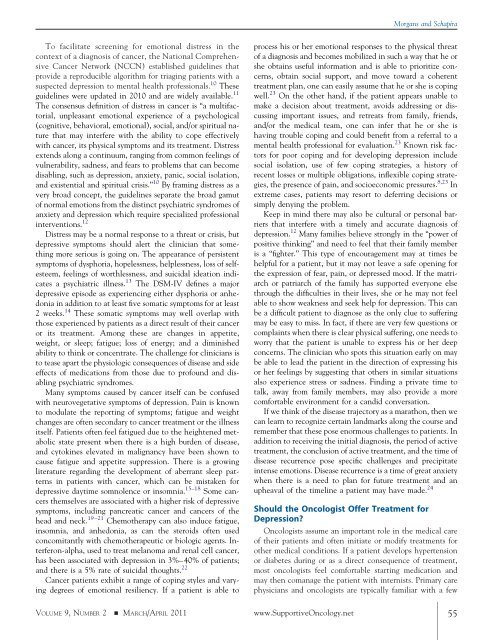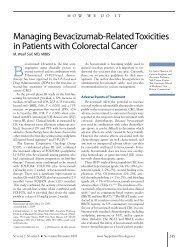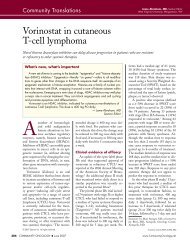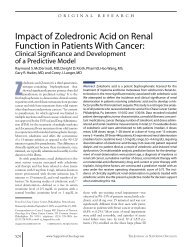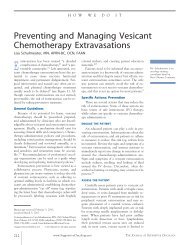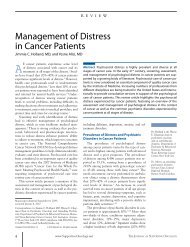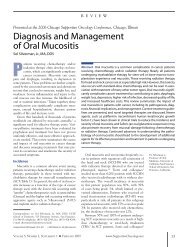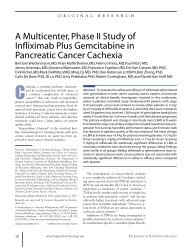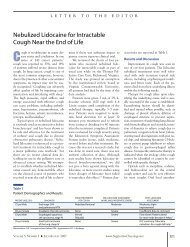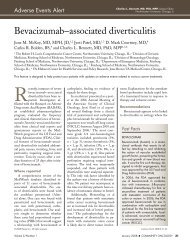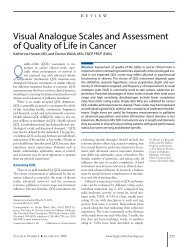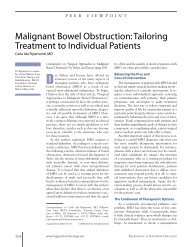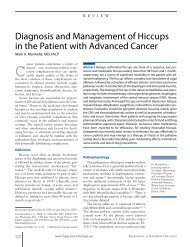Evaluating the “Good Death” Concept from Iranian Bereaved Family
Evaluating the “Good Death” Concept from Iranian Bereaved Family
Evaluating the “Good Death” Concept from Iranian Bereaved Family
Create successful ePaper yourself
Turn your PDF publications into a flip-book with our unique Google optimized e-Paper software.
To facilitate screening for emotional distress in <strong>the</strong><br />
context of a diagnosis of cancer, <strong>the</strong> National Comprehensive<br />
Cancer Network (NCCN) established guidelines that<br />
provide a reproducible algorithm for triaging patients with a<br />
suspected depression to mental health professionals. 10 These<br />
guidelines were updated in 2010 and are widely available. 11<br />
The consensus definition of distress in cancer is “a multifactorial,<br />
unpleasant emotional experience of a psychological<br />
(cognitive, behavioral, emotional), social, and/or spiritual nature<br />
that may interfere with <strong>the</strong> ability to cope effectively<br />
with cancer, its physical symptoms and its treatment. Distress<br />
extends along a continuum, ranging <strong>from</strong> common feelings of<br />
vulnerability, sadness, and fears to problems that can become<br />
disabling, such as depression, anxiety, panic, social isolation,<br />
and existential and spiritual crisis.” 10 By framing distress as a<br />
very broad concept, <strong>the</strong> guidelines separate <strong>the</strong> broad gamut<br />
of normal emotions <strong>from</strong> <strong>the</strong> distinct psychiatric syndromes of<br />
anxiety and depression which require specialized professional<br />
interventions. 12<br />
Distress may be a normal response to a threat or crisis, but<br />
depressive symptoms should alert <strong>the</strong> clinician that something<br />
more serious is going on. The appearance of persistent<br />
symptoms of dysphoria, hopelessness, helplessness, loss of selfesteem,<br />
feelings of worthlessness, and suicidal ideation indicates<br />
a psychiatric illness. 13 The DSM-IV defines a major<br />
depressive episode as experiencing ei<strong>the</strong>r dysphoria or anhedonia<br />
in addition to at least five somatic symptoms for at least<br />
2 weeks. 14 These somatic symptoms may well overlap with<br />
those experienced by patients as a direct result of <strong>the</strong>ir cancer<br />
or its treatment. Among <strong>the</strong>se are changes in appetite,<br />
weight, or sleep; fatigue; loss of energy; and a diminished<br />
ability to think or concentrate. The challenge for clinicians is<br />
to tease apart <strong>the</strong> physiologic consequences of disease and side<br />
effects of medications <strong>from</strong> those due to profound and disabling<br />
psychiatric syndromes.<br />
Many symptoms caused by cancer itself can be confused<br />
with neurovegetative symptoms of depression. Pain is known<br />
to modulate <strong>the</strong> reporting of symptoms; fatigue and weight<br />
changes are often secondary to cancer treatment or <strong>the</strong> illness<br />
itself. Patients often feel fatigued due to <strong>the</strong> heightened metabolic<br />
state present when <strong>the</strong>re is a high burden of disease,<br />
and cytokines elevated in malignancy have been shown to<br />
cause fatigue and appetite suppression. There is a growing<br />
literature regarding <strong>the</strong> development of aberrant sleep patterns<br />
in patients with cancer, which can be mistaken for<br />
depressive daytime somnolence or insomnia. 15–18 Some cancers<br />
<strong>the</strong>mselves are associated with a higher risk of depressive<br />
symptoms, including pancreatic cancer and cancers of <strong>the</strong><br />
head and neck. 19–21 Chemo<strong>the</strong>rapy can also induce fatigue,<br />
insomnia, and anhedonia, as can <strong>the</strong> steroids often used<br />
concomitantly with chemo<strong>the</strong>rapeutic or biologic agents. Interferon-alpha,<br />
used to treat melanoma and renal cell cancer,<br />
has been associated with depression in 3%–40% of patients;<br />
and <strong>the</strong>re is a 5% rate of suicidal thoughts. 22<br />
Cancer patients exhibit a range of coping styles and varying<br />
degrees of emotional resiliency. If a patient is able to<br />
Morgans and Schapira<br />
process his or her emotional responses to <strong>the</strong> physical threat<br />
of a diagnosis and becomes mobilized in such a way that he or<br />
she obtains useful information and is able to prioritize concerns,<br />
obtain social support, and move toward a coherent<br />
treatment plan, one can easily assume that he or she is coping<br />
well. 23 On <strong>the</strong> o<strong>the</strong>r hand, if <strong>the</strong> patient appears unable to<br />
make a decision about treatment, avoids addressing or discussing<br />
important issues, and retreats <strong>from</strong> family, friends,<br />
and/or <strong>the</strong> medical team, one can infer that he or she is<br />
having trouble coping and could benefit <strong>from</strong> a referral to a<br />
mental health professional for evaluation. 23 Known risk factors<br />
for poor coping and for developing depression include<br />
social isolation, use of few coping strategies, a history of<br />
recent losses or multiple obligations, inflexible coping strategies,<br />
<strong>the</strong> presence of pain, and socioeconomic pressures. 8,23 In<br />
extreme cases, patients may resort to deferring decisions or<br />
simply denying <strong>the</strong> problem.<br />
Keep in mind <strong>the</strong>re may also be cultural or personal barriers<br />
that interfere with a timely and accurate diagnosis of<br />
depression. 12 Many families believe strongly in <strong>the</strong> “power of<br />
positive thinking” and need to feel that <strong>the</strong>ir family member<br />
is a “fighter.” This type of encouragement may at times be<br />
helpful for a patient, but it may not leave a safe opening for<br />
<strong>the</strong> expression of fear, pain, or depressed mood. If <strong>the</strong> matriarch<br />
or patriarch of <strong>the</strong> family has supported everyone else<br />
through <strong>the</strong> difficulties in <strong>the</strong>ir lives, she or he may not feel<br />
able to show weakness and seek help for depression. This can<br />
be a difficult patient to diagnose as <strong>the</strong> only clue to suffering<br />
may be easy to miss. In fact, if <strong>the</strong>re are very few questions or<br />
complaints when <strong>the</strong>re is clear physical suffering, one needs to<br />
worry that <strong>the</strong> patient is unable to express his or her deep<br />
concerns. The clinician who spots this situation early on may<br />
be able to lead <strong>the</strong> patient in <strong>the</strong> direction of expressing his<br />
or her feelings by suggesting that o<strong>the</strong>rs in similar situations<br />
also experience stress or sadness. Finding a private time to<br />
talk, away <strong>from</strong> family members, may also provide a more<br />
comfortable environment for a candid conversation.<br />
If we think of <strong>the</strong> disease trajectory as a marathon, <strong>the</strong>n we<br />
can learn to recognize certain landmarks along <strong>the</strong> course and<br />
remember that <strong>the</strong>se pose enormous challenges to patients. In<br />
addition to receiving <strong>the</strong> initial diagnosis, <strong>the</strong> period of active<br />
treatment, <strong>the</strong> conclusion of active treatment, and <strong>the</strong> time of<br />
disease recurrence pose specific challenges and precipitate<br />
intense emotions. Disease recurrence is a time of great anxiety<br />
when <strong>the</strong>re is a need to plan for future treatment and an<br />
upheaval of <strong>the</strong> timeline a patient may have made. 24<br />
Should <strong>the</strong> Oncologist Offer Treatment for<br />
Depression?<br />
Oncologists assume an important role in <strong>the</strong> medical care<br />
of <strong>the</strong>ir patients and often initiate or modify treatments for<br />
o<strong>the</strong>r medical conditions. If a patient develops hypertension<br />
or diabetes during or as a direct consequence of treatment,<br />
most oncologists feel comfortable starting medication and<br />
may <strong>the</strong>n comanage <strong>the</strong> patient with internists. Primary care<br />
physicians and oncologists are typically familiar with a few<br />
VOLUME 9, NUMBER 2 � MARCH/APRIL 2011 www.SupportiveOncology.net 55


